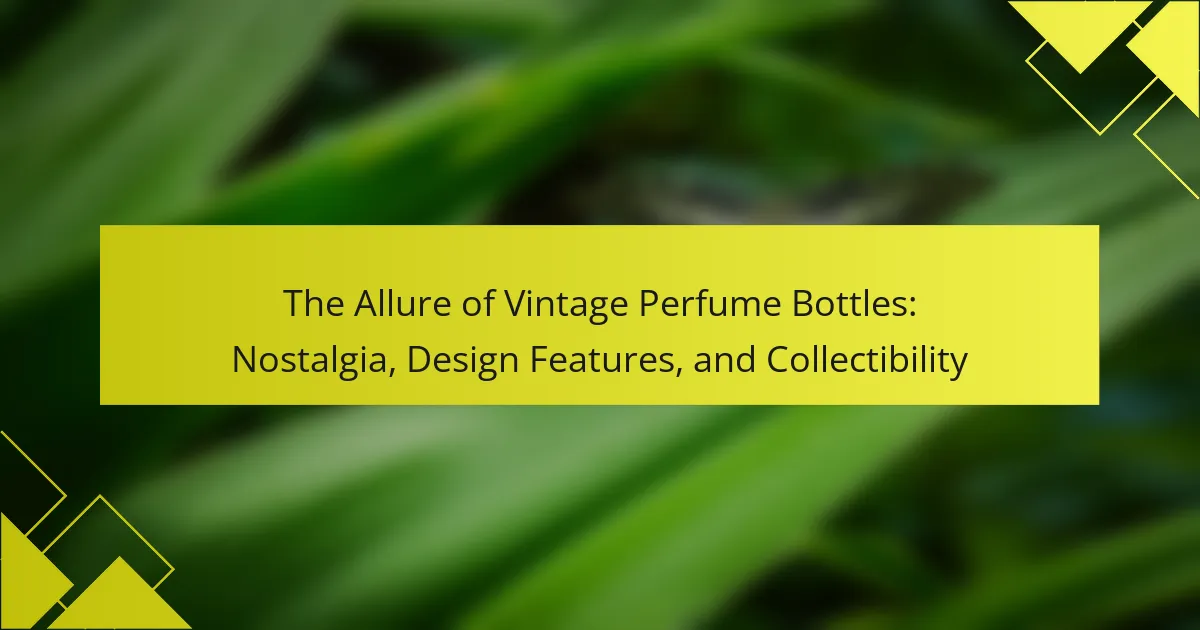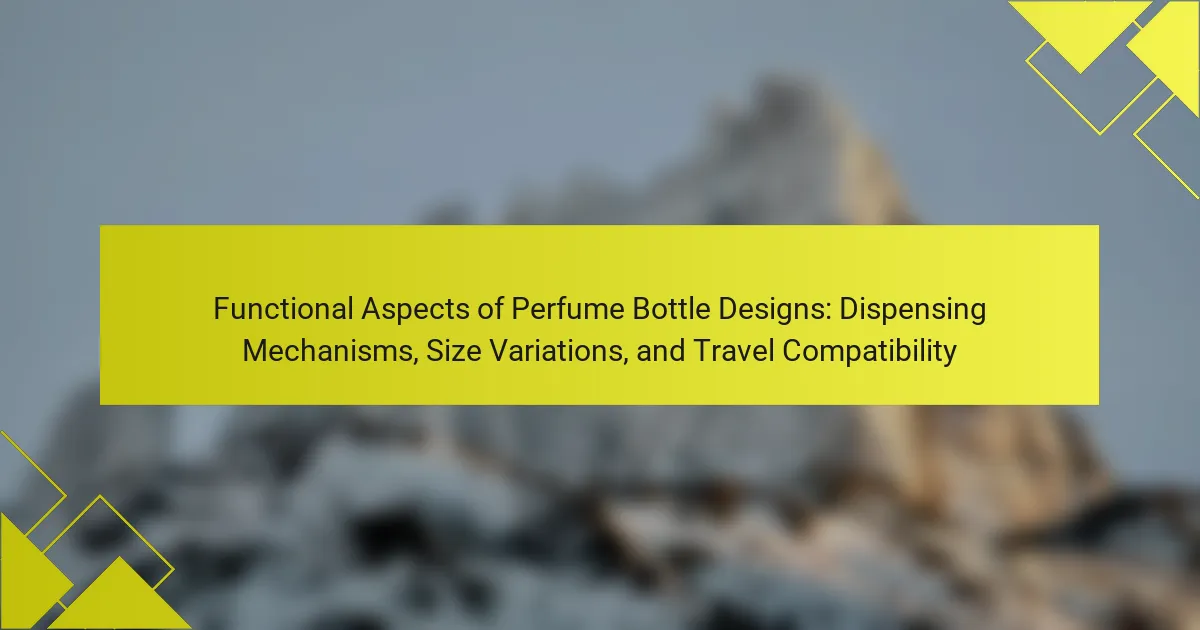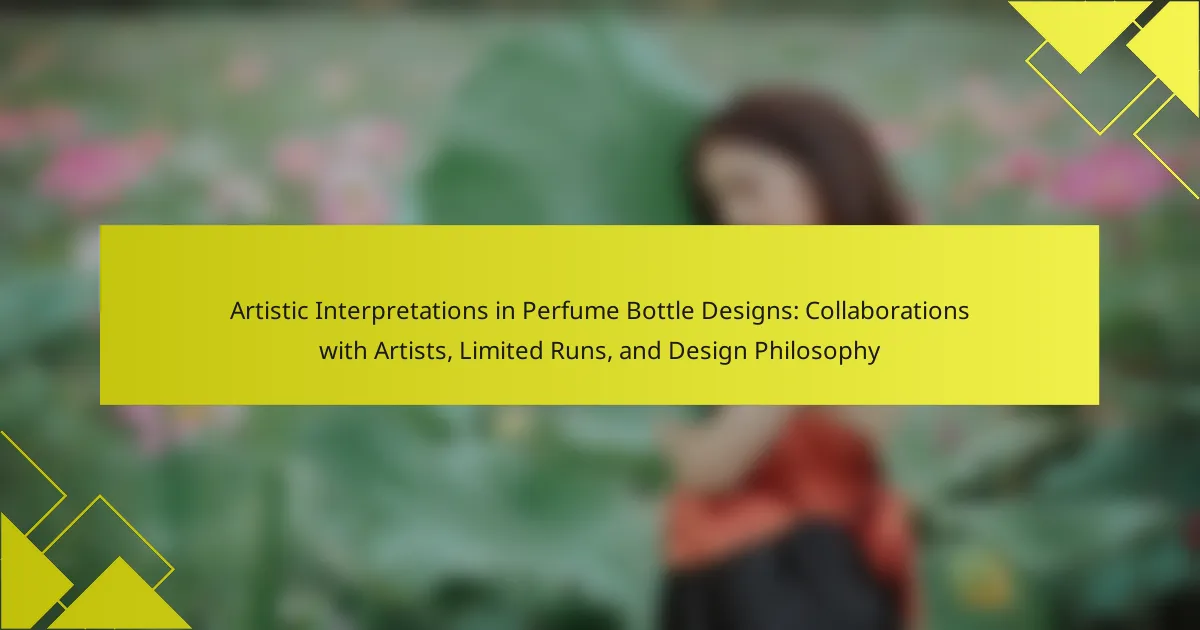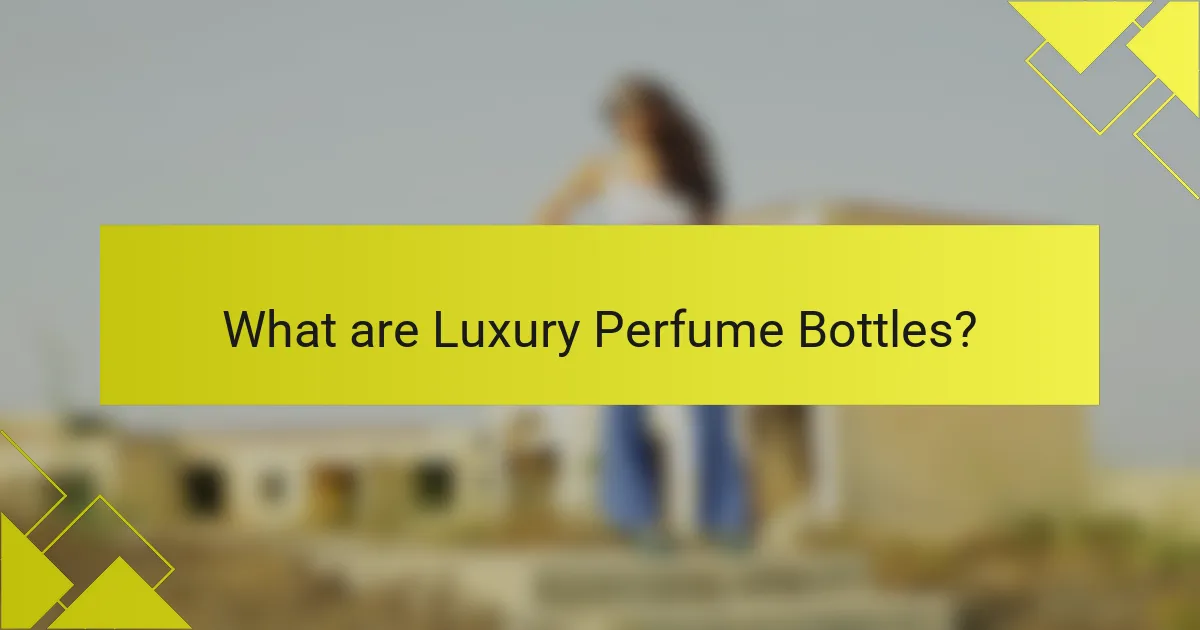
What are Luxury Perfume Bottles?
Luxury perfume bottles are high-end containers designed to hold and present fragrances. These bottles often feature intricate designs and premium materials. Common materials include glass, crystal, and metal. They are crafted to reflect the brand’s identity and enhance the overall aesthetic appeal. Many luxury perfume bottles are collectible items due to their unique artistry. Some brands collaborate with renowned designers to create limited edition bottles. The craftsmanship involved can significantly increase the price point. For example, bottles from brands like Chanel or Dior can cost hundreds to thousands of dollars. The design trends often include vintage styles, minimalism, and bold artistic expressions.
How do Luxury Perfume Bottles differ from Regular Bottles?
Luxury perfume bottles differ from regular bottles primarily in design and materials. Luxury bottles often feature intricate designs, unique shapes, and high-quality materials. Regular bottles typically have simpler designs and are made from standard glass or plastic.
Luxury bottles may use crystal, metal, or hand-painted elements. This enhances their aesthetic appeal and often reflects the brand’s image. Regular bottles do not usually offer such craftsmanship.
Additionally, luxury perfume bottles often come with elaborate packaging. This may include decorative boxes or cases, which add to the overall experience. Regular bottles usually have basic packaging aimed at functionality rather than luxury.
Price points also differ significantly. Luxury perfume bottles can cost significantly more due to their craftsmanship and brand prestige. Regular bottles are generally more affordable and accessible.
What design elements are unique to Luxury Perfume Bottles?
Luxury perfume bottles often feature intricate designs that set them apart. These bottles may include unique shapes that evoke elegance and sophistication. Many luxury brands utilize high-quality materials such as crystal, glass, or metal. The craftsmanship is often meticulous, with hand-finished details enhancing their appeal.
Additionally, luxury perfume bottles may incorporate distinctive closures, like ornate caps or stoppers. Some designs include decorative elements such as engravings or embossed logos. Colors and finishes also play a crucial role, with options ranging from matte to glossy.
The overall aesthetic often reflects the fragrance’s theme, creating a cohesive brand identity. These design elements contribute to the perceived value and exclusivity of luxury perfumes.
How does branding influence the design of Luxury Perfume Bottles?
Branding significantly influences the design of luxury perfume bottles. Luxury brands aim to convey exclusivity and sophistication through their bottle designs. The shape, color, and materials used all reflect the brand’s identity and values. For instance, brands like Chanel and Dior use iconic shapes that are instantly recognizable. Unique bottle designs can enhance brand loyalty and attract consumers. Additionally, high-quality materials like glass and metal are often employed to signify luxury. The overall aesthetic must align with the brand’s marketing strategy to create a cohesive image. Research shows that consumers associate premium packaging with higher product quality. Thus, branding directly impacts both the visual appeal and perceived value of luxury perfume bottles.
What are the common attributes of Luxury Perfume Bottles?
Luxury perfume bottles typically feature high-quality materials, intricate designs, and unique shapes. Common materials include glass, crystal, and metal, which contribute to their elegance. Many luxury bottles are handcrafted, showcasing artisanal craftsmanship. They often incorporate decorative elements like gemstones or gold accents.
The design usually reflects the brand’s identity, making each bottle a work of art. Size and capacity vary, but they often hold between 30ml to 100ml of fragrance. Some bottles are refillable, enhancing sustainability. Additionally, luxury perfume bottles often come in limited editions, increasing their exclusivity.
What materials are typically used in Luxury Perfume Bottles?
Luxury perfume bottles are typically made from glass, crystal, and metal. Glass is favored for its ability to showcase the perfume’s color and design. Crystal adds an element of elegance and luxury due to its clarity and refractive qualities. Metal components, such as caps and decorative elements, are often used for durability and aesthetic appeal. Additionally, some luxury bottles incorporate ceramic or porcelain for unique designs. These materials are chosen for their visual and tactile qualities, enhancing the overall experience of the fragrance.
How do design trends impact the aesthetics of Luxury Perfume Bottles?
Design trends significantly influence the aesthetics of luxury perfume bottles. Modern trends emphasize minimalism, bold colors, and innovative shapes. Minimalist designs create a sense of elegance and sophistication. Bold colors attract attention and convey brand identity. Innovative shapes can evoke emotions and enhance the overall experience. For example, the use of geometric forms reflects contemporary artistic movements. Additionally, eco-friendly materials are becoming popular, aligning with consumer values. This shift impacts how brands present their products visually. The aesthetics of luxury perfume bottles must resonate with current consumer preferences to remain competitive.
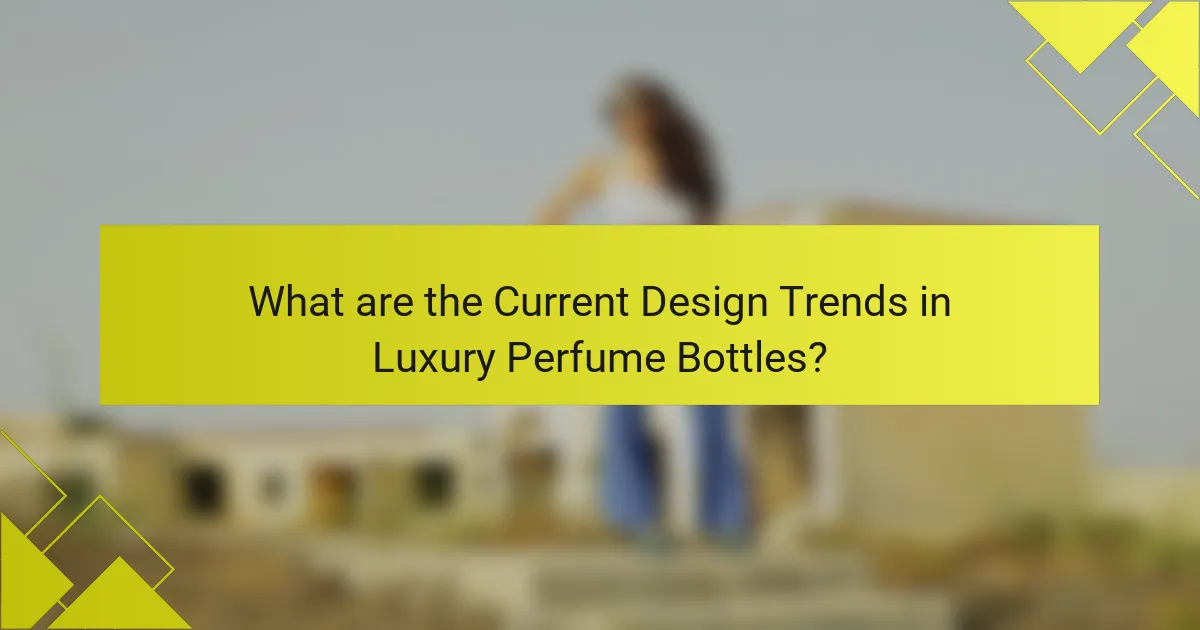
What are the Current Design Trends in Luxury Perfume Bottles?
Current design trends in luxury perfume bottles emphasize minimalism, sustainability, and artistic craftsmanship. Minimalist designs often feature clean lines and simple shapes, allowing the fragrance to take center stage. Sustainability is increasingly important, with brands using eco-friendly materials and refillable options to reduce waste. Artistic craftsmanship is evident in unique bottle shapes and intricate detailing, reflecting the brand’s identity. Additionally, bold colors and innovative textures are being utilized to attract attention and convey luxury. These trends align with consumer preferences for both aesthetic appeal and environmental responsibility.
How have design trends evolved over the years?
Design trends in luxury perfume bottles have evolved significantly over the years. Initially, bottles were simple and functional, focusing primarily on the containment of fragrance. In the early 20th century, artistic influences emerged, leading to elaborate designs featuring intricate shapes and luxurious materials. The Art Deco period introduced geometric forms and bold colors, reflecting the opulence of the era.
By the 1960s and 1970s, minimalism gained popularity, resulting in sleek, modern designs that emphasized purity and simplicity. The late 20th century saw a resurgence of vintage aesthetics, with brands revisiting classic styles while incorporating contemporary elements. Today, sustainability is a key focus, with brands opting for eco-friendly materials and refillable designs.
This evolution reflects broader cultural shifts, consumer preferences, and technological advancements in manufacturing. The luxury perfume market continues to innovate, merging artistry with functionality.
What are the most popular contemporary design styles for Luxury Perfume Bottles?
The most popular contemporary design styles for luxury perfume bottles include minimalist, art deco, and organic forms. Minimalist designs emphasize simplicity and clean lines. They often feature clear glass and subtle branding. Art deco styles incorporate geometric shapes and bold colors. These designs evoke a sense of luxury and vintage elegance. Organic forms mimic natural shapes and curves. They create a sense of fluidity and uniqueness. These styles reflect current trends in aesthetics and consumer preferences. Each design style enhances the overall appeal of the fragrance inside.
How do cultural influences shape design trends in Luxury Perfume Bottles?
Cultural influences significantly shape design trends in luxury perfume bottles. Different cultures bring unique aesthetics and meanings to design elements. For instance, Middle Eastern designs often feature intricate patterns and ornate details, reflecting their rich heritage. In contrast, minimalist Scandinavian designs emphasize simplicity and functionality, showcasing a modern approach.
Additionally, cultural symbols and motifs are frequently integrated into bottle designs. For example, Japanese aesthetics may inspire the use of natural materials and organic shapes. This diversity in design is driven by consumer preferences rooted in cultural identity and values.
Furthermore, global trends can also influence local markets. As luxury brands expand internationally, they adapt designs to resonate with diverse cultural contexts. This adaptation ensures that the products appeal to a broader audience while maintaining brand identity.
Overall, cultural influences are pivotal in shaping the visual language and identity of luxury perfume bottles.
What role does sustainability play in the design of Luxury Perfume Bottles?
Sustainability plays a crucial role in the design of luxury perfume bottles. Many brands are shifting towards eco-friendly materials. This includes using recycled glass and biodegradable packaging. Such choices reduce environmental impact. Additionally, sustainable design often emphasizes minimalism. This approach not only appeals to eco-conscious consumers but also enhances aesthetic value. Brands like Chanel and Gucci have adopted sustainable practices. They aim to align luxury with environmental responsibility. Research indicates that consumers are willing to pay more for sustainable products. This trend influences design decisions in the luxury perfume sector.
What sustainable materials are being used in modern Luxury Perfume Bottles?
Modern luxury perfume bottles utilize sustainable materials such as recycled glass, biodegradable plastics, and sustainably sourced wood. Recycled glass reduces waste and energy consumption in production. Biodegradable plastics break down more easily in the environment compared to traditional plastics. Sustainably sourced wood, often from certified forests, adds a natural aesthetic while ensuring responsible sourcing. These materials reflect a growing trend in the luxury market towards eco-friendly practices. Brands like Gucci and Stella McCartney are leading this shift by incorporating these materials into their designs.
How are brands incorporating eco-friendly practices into their packaging designs?
Brands are incorporating eco-friendly practices into their packaging designs by using sustainable materials. Many luxury perfume brands are opting for recycled glass and biodegradable plastics. This shift reduces environmental impact and enhances brand image. Additionally, brands are minimizing packaging size to decrease waste. Some companies are also implementing refillable bottle systems. This approach encourages consumers to reuse packaging rather than dispose of it. Research shows that 74% of consumers are willing to pay more for sustainable packaging. This statistic highlights the growing demand for eco-friendly practices in the luxury sector.
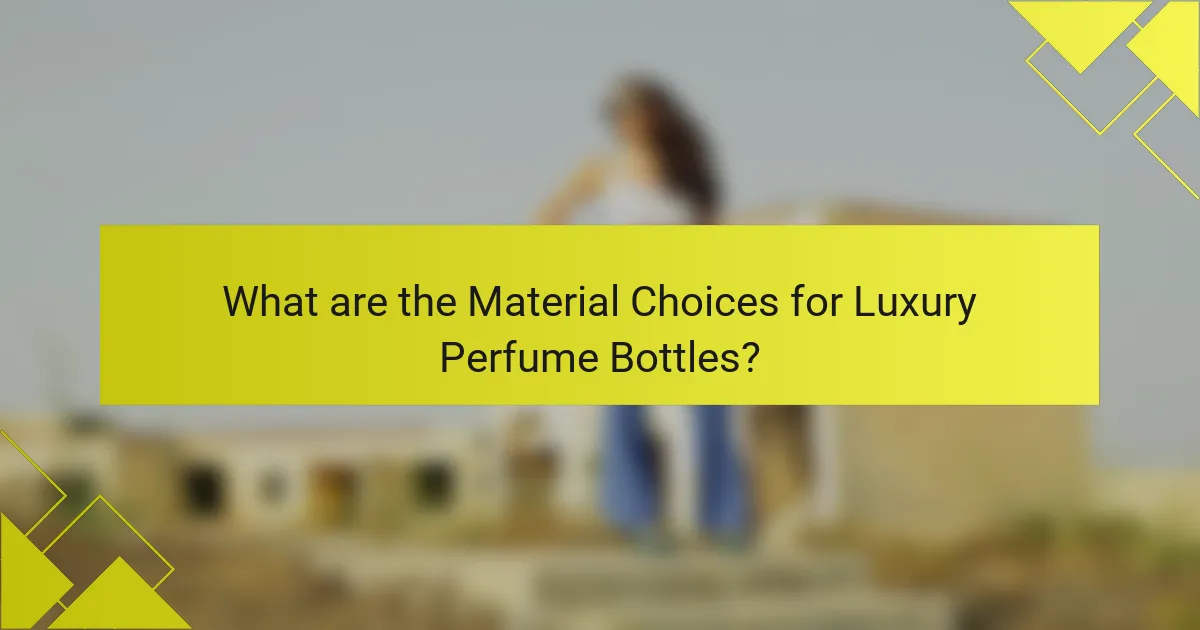
What are the Material Choices for Luxury Perfume Bottles?
Luxury perfume bottles are typically made from glass, crystal, metal, and plastic. Glass is the most common choice due to its ability to preserve fragrance integrity. Crystal offers an elegant aesthetic and is often used for high-end brands. Metal components can provide durability and a modern look, often seen in caps and embellishments. Plastic is occasionally used for its lightweight properties, especially in travel-sized versions. Each material choice contributes to the overall luxury experience, enhancing both visual appeal and functionality.
What are the advantages of glass vs. plastic in Luxury Perfume Bottles?
Glass offers several advantages over plastic in luxury perfume bottles. Glass is non-porous and does not react with fragrance compounds. This ensures the scent remains pure over time. Additionally, glass provides a premium aesthetic. Its weight and clarity enhance the perceived value of the product. Glass bottles are also recyclable, aligning with eco-friendly trends. In contrast, plastic can degrade and alter the fragrance. It may also leach chemicals, affecting scent quality. Overall, glass maintains fragrance integrity and elevates luxury branding.
How does the choice of material affect the fragrance preservation?
The choice of material significantly affects fragrance preservation. Different materials have varying levels of permeability and reactivity. Glass is commonly used for perfume bottles due to its non-reactive nature. It prevents chemical interactions that could alter the fragrance. Plastic, on the other hand, can be permeable. This permeability may allow air and moisture to enter, degrading the scent over time. Metal containers can also react with certain fragrance compounds, potentially changing their composition. Research indicates that high-quality glass bottles maintain fragrance integrity better than other materials. Therefore, selecting the right material is crucial for preserving the intended scent profile.
What are the aesthetic benefits of using different materials in Luxury Perfume Bottles?
Different materials in luxury perfume bottles enhance aesthetic appeal through texture, color, and form. Glass offers clarity and elegance, allowing the fragrance’s color to be showcased. Metal adds a modern and sleek appearance, often reflecting light beautifully. Crystal provides a luxurious, high-end feel with intricate designs that catch the eye. Wood introduces warmth and organic beauty, creating a unique tactile experience. Each material contributes distinct visual characteristics that elevate the overall design. The choice of material can also reflect the brand’s identity and values, influencing consumer perception. Thus, using various materials in luxury perfume bottles significantly enhances their aesthetic benefits.
What unique materials are used in high-end Luxury Perfume Bottles?
High-end luxury perfume bottles often utilize unique materials such as crystal, glass, metal, and exotic woods. Crystal is favored for its clarity and brilliance, enhancing the visual appeal of the fragrance. Glass is commonly used for its versatility and ability to be molded into intricate shapes. Metal accents, often in gold or silver, add a touch of elegance and luxury. Exotic woods can be incorporated into the design, providing a natural and artisanal feel. Some brands also use rare stones or ceramics for added uniqueness. These materials contribute to the overall aesthetic and perceived value of the perfume.
How do precious metals and crystals enhance the luxury appeal?
Precious metals and crystals significantly enhance the luxury appeal of products. Their rarity and intrinsic value are key factors. Precious metals like gold and platinum exude opulence and sophistication. Crystals, such as Swarovski or Baccarat, add brilliance and elegance. These materials are often associated with high craftsmanship and exclusivity. The use of these elements in luxury perfume bottles elevates their aesthetic and perceived worth. For instance, a perfume bottle adorned with gold accents can command higher prices due to its luxurious appearance. This combination of materials creates a sensory experience that resonates with consumers seeking luxury.
What are the implications of using artisanal materials in bottle design?
Using artisanal materials in bottle design enhances aesthetics and brand storytelling. Artisanal materials often convey a sense of craftsmanship and exclusivity. This can attract consumers who value unique, handcrafted products. Bottles made from these materials may also have a higher perceived value.
Additionally, using artisanal materials can differentiate a brand in a competitive market. For example, glass bottles with hand-blown techniques showcase individuality. The tactile experience of such materials can enhance customer engagement.
Furthermore, sustainability is often a consideration with artisanal materials. Brands may appeal to environmentally conscious consumers by using locally sourced or eco-friendly materials. This approach aligns with current trends toward sustainability in luxury markets.
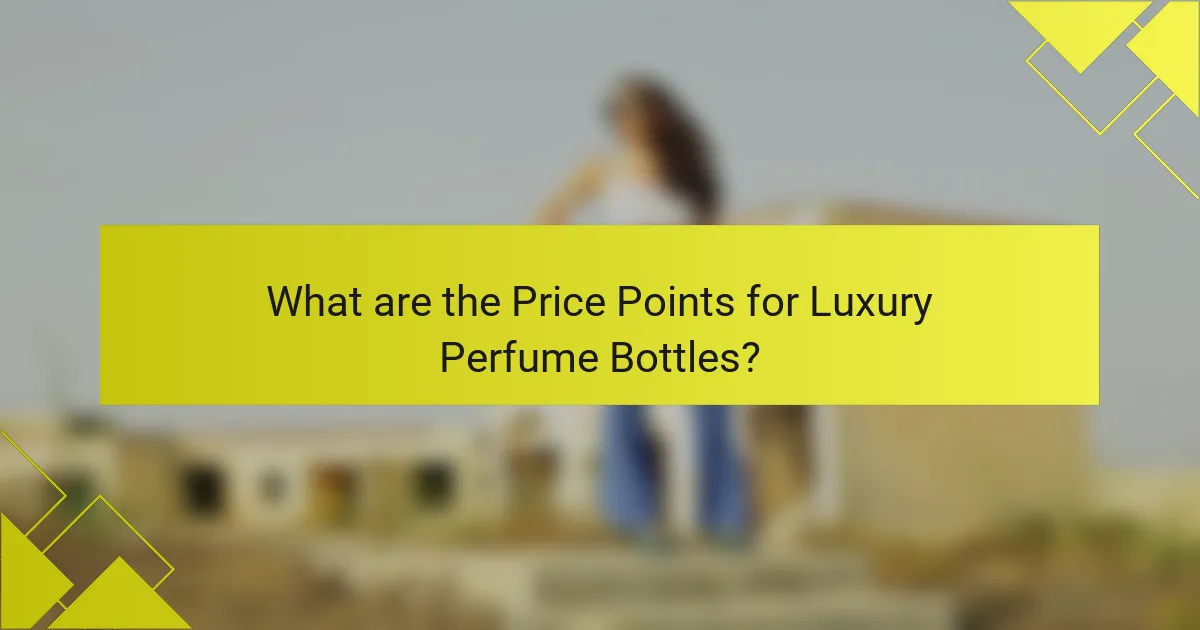
What are the Price Points for Luxury Perfume Bottles?
Luxury perfume bottles typically range in price from $100 to over $1,000. The price is influenced by factors such as brand reputation, design complexity, and materials used. High-end brands like Chanel and Dior often price their bottles between $150 and $300. Unique designs or limited editions can elevate prices to $500 or more. Some artisanal brands may offer bottles that exceed $1,000 due to bespoke craftsmanship. The luxury market values exclusivity, which often justifies higher price points.
How do the price points vary among different brands?
Price points among different luxury perfume brands vary significantly. High-end brands like Chanel and Tom Ford often price their bottles between $200 and $500. Mid-tier brands, such as Marc Jacobs and Dolce & Gabbana, typically range from $100 to $200. More affordable luxury options, like Jo Malone, usually cost between $50 and $100. Factors influencing these price variations include brand reputation, ingredient quality, and packaging design. For instance, exclusive ingredients and bespoke bottle designs can elevate prices in premium brands.
What factors contribute to the high cost of Luxury Perfume Bottles?
The high cost of luxury perfume bottles is influenced by several key factors. Firstly, the materials used in their production significantly impact pricing. High-quality glass, metals, and intricate embellishments are common in luxury designs. Secondly, the craftsmanship involved in creating these bottles is often meticulous and time-consuming. Skilled artisans may spend hours perfecting each piece.
Additionally, limited editions or exclusive designs can drive up costs due to their rarity. The brand reputation also plays a crucial role; established luxury brands can command higher prices. Furthermore, the marketing and packaging associated with luxury perfumes contribute to the overall expense. Luxury brands often invest heavily in branding to create an image of exclusivity.
Lastly, the functionality of the bottle, such as unique dispensing mechanisms, can add to its cost. These factors combined create a high price point for luxury perfume bottles.
How does limited edition status affect pricing of Luxury Perfume Bottles?
Limited edition status significantly increases the pricing of luxury perfume bottles. This exclusivity creates a perception of rarity and desirability among consumers. Limited editions often feature unique designs or formulations, enhancing their appeal. As a result, brands can command higher prices due to the perceived value. Historical data shows that limited edition perfumes can sell for 20% to 50% more than regular lines. For instance, a limited edition bottle from a renowned brand may retail at $300, while its standard counterpart is priced at $200. The scarcity of limited editions drives demand, further inflating prices in secondary markets. Thus, limited edition status plays a crucial role in luxury perfume pricing strategies.
What are the trends in consumer spending on Luxury Perfume Bottles?
Consumer spending on luxury perfume bottles has been steadily increasing. In 2022, the global luxury fragrance market was valued at approximately $14 billion. This growth is driven by rising disposable incomes and a growing appreciation for high-end products. Consumers are increasingly seeking unique designs and artisanal craftsmanship in perfume bottles. Eco-friendly materials and sustainable practices are also becoming important to buyers. The trend towards personalization is evident, with more brands offering customizable options. Online sales channels have gained traction, allowing consumers to explore luxury options more conveniently. Overall, the luxury perfume bottle market is evolving, reflecting broader consumer trends toward exclusivity and sustainability.
How do market demographics influence the pricing strategy of Luxury Perfume Bottles?
Market demographics significantly influence the pricing strategy of luxury perfume bottles. Factors such as age, income, and geographic location determine consumer purchasing power. Younger consumers may prefer trendy designs at lower price points. In contrast, older demographics often seek exclusivity and are willing to pay premium prices.
Income levels also play a crucial role. Higher-income consumers expect luxury products to reflect their status and may favor limited editions. Geographic location affects pricing due to varying economic conditions and consumer preferences. For example, luxury perfumes may be priced higher in affluent urban areas compared to rural regions.
Brands analyze demographic data to tailor their pricing strategies. This ensures alignment with consumer expectations and maximizes sales potential. By understanding these demographics, luxury perfume brands can effectively position their products in the market.
What are the expectations of consumers regarding value and quality in Luxury Perfume Bottles?
Consumers expect high value and exceptional quality in luxury perfume bottles. They seek exquisite design that reflects elegance and sophistication. Materials used should be premium, such as glass or crystal, enhancing the overall aesthetic. Durability is crucial; consumers want bottles that last and maintain their appearance. The craftsmanship must be meticulous, showcasing attention to detail. Additionally, consumers appreciate unique designs that stand out in the market. A luxury perfume bottle should also provide an experience, from the look to the feel. These expectations are driven by the high price point associated with luxury brands, which often range from $100 to $500 or more.
What tips should consumers consider when purchasing Luxury Perfume Bottles?
When purchasing luxury perfume bottles, consumers should consider the design, material, and brand reputation. The design should reflect personal style and aesthetic preferences. Materials like glass or crystal often indicate quality and durability. Consumers should also check for craftsmanship details, as these can enhance the overall luxury experience. Brand reputation plays a crucial role in ensuring authenticity and value. Limited editions may offer unique attributes that increase desirability. Lastly, price points should align with budget while considering the investment value of the bottle.
How can consumers assess the quality of Luxury Perfume Bottles?
Consumers can assess the quality of luxury perfume bottles by examining several key factors. First, check the materials used in the bottle’s construction. High-quality glass or crystal is often a sign of luxury. Second, evaluate the craftsmanship. Smooth edges and intricate designs indicate superior workmanship. Third, consider the weight of the bottle. Heavier bottles typically suggest higher quality materials. Fourth, inspect the closure mechanism. A well-designed cap or sprayer enhances user experience and reflects quality. Finally, review brand reputation. Established luxury brands often maintain higher standards in their products. These factors collectively help consumers determine the quality of luxury perfume bottles.
What should consumers know about the longevity of fragrances in Luxury Perfume Bottles?
Fragrances in luxury perfume bottles typically last longer due to higher concentrations of essential oils. These perfumes often contain 20-30% oil, compared to 5-15% in mass-market products. The quality of ingredients also contributes to longevity, as premium components evaporate more slowly. Additionally, the design of luxury bottles often includes airtight seals that protect the fragrance from air exposure. Proper storage in a cool, dark place can further enhance longevity. Studies indicate that fragrances can last from 4 to 8 hours on the skin, depending on the formulation. Factors such as skin type and climate also influence how long a fragrance lasts. Overall, consumers can expect better longevity from luxury perfumes compared to standard options.
Luxury perfume bottles are high-end containers designed to showcase fragrances, featuring intricate designs and premium materials such as glass, crystal, and metal. The article explores the differences between luxury and regular bottles, emphasizing unique design elements, branding influences, and current trends in aesthetics. It also discusses sustainability in packaging, material choices, and the implications of artisanal craftsmanship on pricing. Additionally, the article analyzes consumer expectations regarding value and quality, providing insights into the pricing strategies and market demographics that shape luxury perfume bottle sales.
